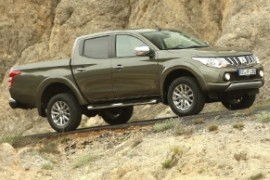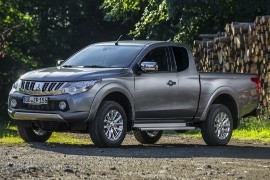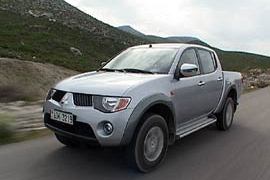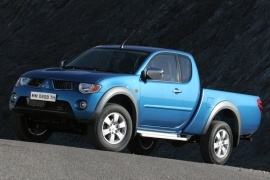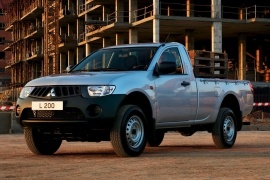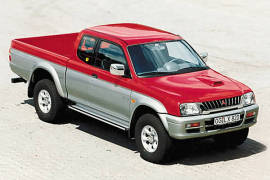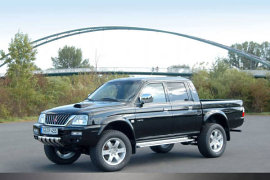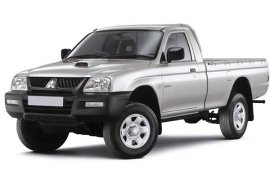MITSUBISHI L 200 Models/Series Timeline, Specifications & Photos
First production year: 1995
Engines: Diesel, Gasoline
Body style: Truck
Mitsubishi introduced the fifth generation of the L200 in Europe in 2015 and had to comply with the strict Euro 6 emission standards, forcing the automaker to improve the engine and safety systems.
The Japanese automaker was known worldwide for its rugged off-road utility vehicle. While this pickup was not available in the U.S., the rest of the world knew it as the L200, the Triton, or the Strada. At first sight, it looked more like a heavily facelifted version of its predecessor. On the other hand, Mitsubishi said it was completely new despite sharing the same wheelbase as the 2005 L200 pickup. Like that model, it was available with a single or a double cab. While the former was mostly a workhorse, the latter was more of a family vehicle good for everything.
Mitsubishi’s design department struggled to get a new front fascia for the car and added a sharp nose to the L200. Its swept-back headlights flanked a broad chromed upper grille. At the same time, in the bumper, the automaker offered customers the option to equip the car with round fog lamps, while underneath the apron, the pickup sported a skid-plate-like trim. As an option, depending on the market, the car could be fitted with a steel plate instead of plastic decoration.
From its profile, the car had a horizontal line that crossed the bodywork from headlights to taillights, crossing over the doors and the bed. The arched lines of the rear side windows and the sculptured door panels made the L200 look more like a family SUV than a rugged off-road utility vehicle. At the back, the automaker installed corner-mounted taillights surrounded by chromed trims and flanking the tailgate. The spare wheel was placed under the bed, behind the rear axle.
Inside, Mitsubishi tried to create an SUV-like cabin fit for daily use. Still, the materials on the dashboard, door cards, and center console resembled those from an LCV. On the other hand, depending on the market and options, customers could have the car fitted with buttons on the steering wheel and a color touchscreen for the infotainment system mounted atop the center stack featuring Apple CarPlay and Android Auto. Fronting the driver was a clean-looking instrument cluster filled with two wide dials for the tachometer and speedometer that flanked a black and white LCD that showed data from the car’s onboard computer. In the back, the bench seat had an almost straight-up backseat, which made long travels uncomfortable for tall people. Behind, in the bed, the L200 provided enough load space for most farmers’ needs in Europe. With a one-ton payload, the L200 proved efficient for most jobs of a light pickup truck.
Under the skin, the 2015 L200 featured a new 2.4-liter turbo diesel powerplant that came in two power levels paired with either a six-speed manual or a five-speed automatic. But the car’s most essential asset was its 4x4 system known as the Super Select. It featured three differentials with a read diff-lock from a button on the center console and a transfer box with high and low range gears.
Between the single cab and the double cab, Mitsubishi had the Club Cab version for the L200’s fifth generation that broke cover in 2015, a vehicle designed mostly to haul but still able to carry five people onboard.
With a not-so-good financial status, Mitsubishi had to rely on the older platform developed for the fourth generation of the L200. Still, the automaker said that the 2015 L200 was a completely new model, even though the entire lineup had the exact same wheelbase and suspension system as its predecessor. The design, on the other hand, the cabin and the drivetrain were different. Besides the Club Cab, the automaker also offered a single-cab base model built mostly as a workhorse and a double-cab version with four regular doors that were mostly suitable for families going camping or off-road.
For the 2015 model year, the L200 received new, swept-back headlights that followed an organic shape with sharp lines. Between them, Mitsubishi installed a broad chromed grille that sported the three-diamond-shaped badge. A set of fog lamps was available as an option on the apron, while underneath the bumper, the automaker installed a plastic trim that mimicked a skid plate.
In the Club Cab version, the pickup featured two front-hinged front doors and a set of suicide doors for those seated in the back. The bed was longer than on the Double Cab and could carry more items. Still, despite its utilitarian look, this version was fit for those who sometimes needed a team of up to five people on the field. Even though Mitsubishi designed the Club Cab mostly as a workhorse, it still cared about styling. As a result, a crease ran along the vehicle from the headlights to the taillights, crossing the door panels.
Inside, the 2015 L200 featured bucket seats at the front divided by a narrow center console and an armrest. Fronting the driver was an instrument cluster filled with the large dials of the tachometer and speedometer. In addition, a center-mounted black-and-white LCD showed other data from the car’s onboard computer. In the back, the automaker installed a bench seat with an almost vertical seatback. As a result, the car was not exactly comfortable. On the other hand, the driver had the option for buttons on the steering wheel and a touch-screen infotainment unit.
Under the skin, the 2015 L200 featured a new 2.4-liter turbo diesel powerplant that came in two power levels paired with either a six-speed manual or a five-speed automatic. But the car’s most essential asset was its 4x4 system known as the Super Select. It featured three differentials with a read diff-lock from a button on the center console and a transfer box with high and low-range gears.
Mitsubishi introduced in 2005 a new generation of its trustworthy L200 pickup, which was sold under the Triton name on specific markets.
The Japanese automaker understood that customers started to use pickups for leisure, not only for work. That convinced it to design the vehicle more carefully, so it could attract more buyers. Soon, thanks to the features and amenities introduced for the 2005 L200/Triton, the vehicle became a benchmark in the lifestyle-pickup segment in the European and Asian markets. Moreover, the four-door version, named Double Cab, was practical for an entire family.
For the second generation of the vehicle, Mitsubishi introduced a new design language with rounded shapes and sharp angles. Its raked grille and pentagonal headlights were unusual for a pickup. In addition, the plastic, wrapped-around bumper sported the grille mounted on a body-colored vertical slat in the middle of the grille. To keep the vehicle's length short enough, the Double Cab version was fitted with a shorter bed in the back than on the Crew-Cab.
The cabin was fit for hosting up to five passengers on high-mounted seats at the front and a bench in the back. But the hard-plastic dashboard still reminded customers that underneath those rounded lines was a hard-core workhorse and a very capable off-road machine. Depending on the trim level, the car could've been fitted with leather upholstery, a capable CD stereo, and power windows on all four.
Under the hood, depending on the market, Mitsubishi installed various engines. The L200 was available with either a choice of four engines. Two turbo-diesel versions, a 2.5-liter or a 3.2-liter, or two gasoline powerplants with 2.4-liter or 3.5-liter displacement.
The second generation of the L200, named Triton on specific markets, brought a new design language for the trustworthy Japanese pickup and improved drivetrains.
With the second generation of the L200, Mitsubishi tried to offer more than just a rugged workhorse. It introduced the vehicle as a lifestyle pickup, with a more refined design than its predecessor. But it kept its rough off-road abilities while it offered a different look than a farm tractor.
In the Crew-Cab version, the L200/Triton featured a new design language, with rounded shapes and sharp angles. Its raked grille and pentagonal headlights were unusual for a pickup. Its plastic, wrapped-around bumper sported the grille mounted on a body-colored vertical slat in the middle of the grille. The crew cab was more extended than the single cab version, but it offered just two doors. Thus, it could provide more interior room than the single cab, but it still had a 2220 mm (7.3 ft) long bed, which was more than what the double-cab could provide.
Inside, the carmaker installed a pair of bucket seats at the front separated by a tall center console with an armrest. Regardless of the trim level, it featured the same hard-plastic dashboard, which reminded the customers that it could do hard-working jobs. Behind the front seats, the carmaker added a storage area. Also, thanks to the more extended cabin, the front seats could still tilt while they were all the way pushed back.
Under the hood, depending on the market, Mitsubishi installed various engines. The L200 was available with either a choice of four engines. Two turbo-diesel versions, a 2.5-liter or a 3.2-liter, or two gasoline powerplants with 2.4-liter or 3.5-liter displacement.
Mitsubishi built the L-200/Triton single cab as the family's workhorse. As a result, it could carry the biggest loads and, in addition, perform great off-road.
The second generation of the L200 (named Triton on specific markets) was unveiled in 2005. Like its predecessor, it came in three shapes: single-cab, crew-cab, and double-cab. The single-cab version was designed mainly as a workhorse, being fitted with the most extended bed in the lineup and offered the lowest starting price. But unlike its predecessor, the 2005 model year tried to gain more points for its design.
Mitsubishi offered the base version of the L200 single-cab with an unpainted plastic front bumper, steel wheels, and black door handles and mirrors. Unlike most other pickups on the market, the L200 featured a rounded cabin shape, with lines inspired by SUVs and crossovers.
Inside, there were just two bucket seats divided by a low center console. As an option, Mitsubishi offered a wider seat for the side passenger, so there was a narrow space for a third occupant. But for those who used this version of the L200 as a recreational vehicle, the carmaker offered more features such as power windows and locks, power mirrors, air conditioning, and an infotainment unit placed atop the center stack.
Under the hood, depending on the market, Mitsubishi installed a four-pot turbodiesel, either with a direct injection or indirect injection system. The five-speed manual was standard, and a four-speed automatic was available for selected markets. In addition, a two-speed transfer case was fitted for the 4x4 versions. Alas, a 2x4 base model was on the table as well, with just rear-wheel drive.
Mitsubishi introduced the second generation of the L200 in 1995 and offered it in three cab versions, with the Crew-Cab positioned between the two-seat Single-Cab and the five-seat Double-Cab.
Sometimes, a contractor needed more workers for a job, but most of the time, he needed more loading area. In that situation, he wouldn't choose a double cab, which was more expensive, nor a single cab since it didn't have any rear seats. The Crew-cab offered a lower price than its four-door sibling, but it still had enough loading area for tools and materials.
Its design showed softer edges and curved lines over the front end and door panels. But it didn't forget its origins and tried to be also a rugged, go-anywhere vehicle. Unlike other American pickups, the L200 didn't have rear-hinged half-doors in the back; it only had two regular doors. Despite being an all-terrain vehicle, it showed smoother lines on the bodywork and curved panels.
Inside, the base version also offered a blue-collar interior, with cloth seats, cranked windows, and plastics hard and poorly finished. It could carry one metric ton and still didn't complain about minimum wage or lunch break. The pop-out rear windows were more than enough to cool the cabin if the owner didn't opt for an AC unit. But Mitsubishi offered the Warrior top-spec version on selected markets. That one was mainly for those who needed just a two-seat pickup with more room behind the seats for luggage and a bed where they could load a pair of bikes.
Under the hood, Mitsubishi installed a 2.5-liter turbo-diesel engine paired with a five-speed manual. Depending on the market, it was available with a 4x4 system with a transfer box and low-range gear.
With an increased demand in the pickup segment and a big experience in building 4x4 vehicles, the L200 Double Cab was a good mix between a workhorse and a leisure vehicle for a family.
While its previous generations were more like test-beds for a future best-seller, the third was the right pickup to wear the Mitsubishi badge. It was big enough for five adults, with a decently-sized bed in the back and a trusted platform that could take the vehicle on any rough terrain.
Its design showed softer edges and curved lines over the front end and door panels. But it didn't forget its origins and tried to be also a rugged, go-anywhere vehicle. The four-door version featured a longer cabin, fit for five adults. Despite being an all-terrain vehicle, it showed smoother lines on the bodywork and curved panels. The only rectangular shape, yet rounded on the corners, was found on the headlights, which were well-protected in deeper clusters. As an option, Mitsubishi offered chromed bush-guards and a sturdy roll-bar mounted behind the cabin.
Inside, the base version also offered a blue-collar interior, with cloth seats, cranked windows, and plastics hard and badly finished. It could carry one metric ton and still didn't complain about minimum wage or lunch break. But most customers went for better-equipped vehicles that provided air-conditioning and power windows and mirrors. The L200 provided room for five with a center console between the front occupants and a flat floor in the back.
Under the hood, Mitsubishi installed a 2.5-liter turbo-diesel engine paired with a five-speed manual. Depending on the market, it was available with a 4x4 system with a transfer box and low-range gear.
MITSUBISHI L200 Double Cab 2.5L D 5MT RWD (76 HP)
MITSUBISHI L200 Double Cab 2.5L TD 5MT AWD (113 HP)
MITSUBISHI L200 Double Cab 2.5L TD 5MT AWD (133 HP)
MITSUBISHI L200 Double Cab 2.5L TD 5MT AWD (90 HP)
MITSUBISHI L200 Double Cab 2.5L TD 5MT AWD (98 HP)
The third generation of the pickup range in Mitsubishi was an important step forward for the Japanese carmaker, which gave it a split personality as a workhorse and leisure vehicle.
While its first pickup generation was more of an underpowered Ford Ranchero, the second generation was the transition toward a 4x4 utility vehicle. Also, it tried to adapt it and make it friendlier with its users and gave them a few comfort features. But the third one was designed right from the start as a true, multipurpose vehicle.
Its design showed softer edges and curved lines over the front end and door panels. But it didn't forget its origins and tried to be also a rugged, go-anywhere vehicle. The carmaker made it available as a Single-Cab, Crew-Cab and Double-Cab, with the former being offered as the entry-level version with the longest bed.
Inside, the base version also offered a blue-collar interior, with cloth seats, cranked windows and plastics hard and badly finished. But, at the end of the day, that vehicle had the job done without complaints. It could carry one metric ton and still didn't complain about minimum wage or lunch break. Unlike its bigger brothers, who offered wider cabins, the single-cab version provided room for two with a center console between them and a gear-stick that popped up through the floor. Depending on the trim level and version, it could have been fitted with air-conditioning and power windows and mirrors.
Under the hood, Mitsubishi installed a 2.5-liter turbo-diesel engine paired with a five-speed manual. Depending on the market, it was available with a rear or 4x4 system with a low-range gear.
